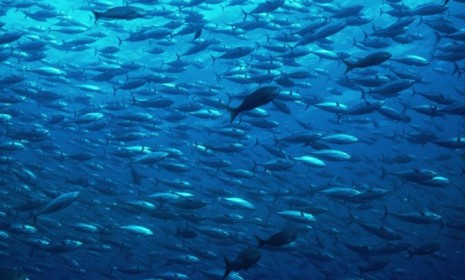How Fukushima's radiation got into California's tuna
Surprisingly, bluefin tuna have carried radiation from Japan's Fukushima nuclear meltdown to U.S. waters. Here's how it happened, and how it affects sushi

Last August, four months after engineers at Japan's tsunami-ravaged Fukushima nuclear power plant dumped radioactive contaminants into the ocean, U.S. scientists were stunned to find higher-than-normal measurements of radioactive cesium-134 and cesium-137 in bluefin tuna caught off the coast of Southern California. Now, the team of marine researchers has confirmed that the radiation in the California tuna is from Fukushima, some 6,000 miles across the vast Pacific. Here's what you need to know:
What's the gist of the study?
Stanford marine ecologist Daniel Madigan tested 15 young bluefin caught off the coast of San Diego, as part of a study on fish migration in the Pacific. He was surprised to find the cesium isotopes — in all 15 of the fish — so he sent the samples to marine radiation specialists Nicholas Fisher and Zofia Baumann at New York's Stony Brook University. In their study, published Monday in the Proceedings of the National Academy of Sciences, the researchers say the young bluefin ingested the radiation off the coast of Japan, then sped across the Pacific to fatten up, arriving months ahead of Fukushima debris.
The Week
Escape your echo chamber. Get the facts behind the news, plus analysis from multiple perspectives.

Sign up for The Week's Free Newsletters
From our morning news briefing to a weekly Good News Newsletter, get the best of The Week delivered directly to your inbox.
From our morning news briefing to a weekly Good News Newsletter, get the best of The Week delivered directly to your inbox.
Are they sure the radiation is from Japan?
The findings "are unequivocal," says Ken Buesseler of the Woods Hole Oceanographic Institution. "Fukushima was the source." (Buesseler was not involved in the research.) The big tell is that cesium-134 and cesium-137 are produced only by human nuclear activity — weapons or power generation — and tests of fish from before the Fukushima disaster found no cesium-134 and low levels of slower-decaying cesium-137, probably from Cold War–era nuclear testing. The "modestly elevated" count of both those isotopes, plus the migration pattern of the fast-swimming bluefin, pointed directly at Fukushima. "We were frankly kind of startled," Fisher tells The Associated Press. "That's a big ocean. To swim across it and still retain these radionuclides is pretty amazing."
Why is this so surprising?
Previously, scientists didn't think large migratory fish like bluefin could carry radioactivity with them for this long a time and distance, because they shed radiation as they swim and grow larger. The researchers will study a larger sample of recently migrated California bluefin this summer, to see if living in the contaminated water off Japan for a year — rather than a month like the sample batch — increases or decreases radiation levels. "We don't think there will be any public health concern from the results of the new tests," Fisher tells the San Francisco Chronicle, "but if we do see any higher concentrations of cesium, we will certainly alert public health agencies again."
A free daily email with the biggest news stories of the day – and the best features from TheWeek.com
So it's still safe to eat tuna?
Madigan says the cesium numbers, while 10 times higher than normal, are well within U.S. and Japanese safety limits. "Some people feel that any amount of radioactivity, in their minds, is bad and they'd like to avoid it," he told Reuters. "But compared to what's there naturally... it's not a large amount at all." In fact, it's "a trivial amount," says Richard Harris at NPR. "If you are still worried about the cesium from Fukushima," consider the amount of tuna you'd have to eat to get in the danger zone: 2.5 to 4 tons in a year, according to expert Robert Emery. "That's a lot of sushi." And most of the California bluefin is shipped back to Japan, anyway.
Is there any good news in the study?
Yes, at least for the cause of research. The findings are "a testament to how well scientists can now measure tiny amounts of radiation," says NPR's Harris, and if they can find similar "tracers" of cesium in sea turtles, sharks, seals, seabirds, and other wildlife, marine researchers can study migration patterns using these "accidental 'tags' instead of using the labor-intensive plastic ones."
Sources: AP, Guardian, NPR, Reuters, San Francisco Chronicle
-
 The week’s best photos
The week’s best photosIn Pictures A man's best friend, the elephants in the room, and more
-
 A TikTok trend has Gen Z men leaving streetwear behind for more preppy attire
A TikTok trend has Gen Z men leaving streetwear behind for more preppy attireThe Explainer More than a zipper: Young Black men embrace the ‘quarter-zip movement‘
-
 Codeword: December 12, 2025
Codeword: December 12, 2025The daily codeword puzzle from The Week